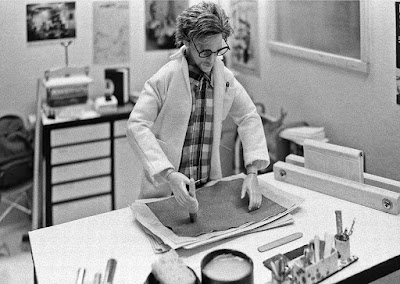The ground in Syracuse (NY) still has snow and the temperatures are still unseasonably cold from time to time, BUT the Sun crosses the Equator tomorrow and the first day of spring is here. The days are getting longer, our clocks "sprung" forward in the US on the 8th, so why not "celebrate" one of my favorite binding structures, the springback.
Hier in Syracuse, NY, liegt noch Schnee, die Temperaturen sind noch gelegentlich niedriger als normal, ABER die Sonne überquert den Equator morgen und der Frühling ist hier! Die Tage werden länger und wir haben in den USA am 8. auf Sommerzeit umgestellt. Also, warum nicht den Frühling mit dem Sprungrücken feiern? (im Englischen ein "gutes" Wortspiel...)
Above the logo for the first
Bonefolder Bind-O-Rama (2004) that was featured on the cover of the
Bonefolder. While published in the fall, the
Bonefolder was announced early in the spring.
Oben, das Logo für das erste Bind-O-Rama des Bonefolder von 2004. Das Heft kam im Herbst des Jahres zum ersten Mal heraus, wurde aber im Frühling angekündigt.
And from the Bind-O-Rama, this miniature springback by Roberta Lavadour.
 |
| “A Counting” – English-style springback, leather
cover with double straight bands laced with deer vellum. 600 pages of 9 lb.
Canary paper with painted edges. Inscription notes the multiplier for each of
the 300 page spreads needed to equal the number of dead and wounded American
soldiers and Iraqi civilians since March 2003. 7.5 x 7 x 2.5 cm. Bound 2004. |
 |
| The mechanics of this springback reflect Richard Bakers demonstration
at the Guild of Book Workers Seminar on Standards of Excellence in Hand Bookbinding
in Denver CO, with a few references to Vaughans 1929 classic, Modern Bookbinding.
The new purpose of this springback is to pop up the pop-up. The book measures
5.5 inches by 6.5 inches by 1.5 inches. Bound 2004. |
 |
| Historical ledger bindings in an archive... |
The structure is most common to the German and English binding traditions and has seen increased interest in the US since the early 2000s with articles and presentations largely by Peter D. Verheyen, Donia Conn, Richard Baker, and
Karen Hanmer.
Sprungrücken gibt es am Häufigsten in der deutschen und englischen Buchbindertradition, und hat in den USA aber Anfang der 2000er neue Aufmerksamkeit gesehen in Aufsätzen, Vorführungen, und Kursen, hauptsächlich durch Peter D. Verheyen, Donia Conn, Richard Baker, und Karen Hanmer.
 |
Poster for the German tradition by Verheyen and Conn based on materials for our article in The New Bookbinder.
Guild of Book Workers Standards Friday Forum poster session, Minneapolis, MN, 2002 |
Cut-away model of German springback
Schnittmodell vom deutschen Sprungrücken
 |
Interactive cut-away diagram (auf Englisch) here
|
These tutorials, with bibliographies can be found at |
Anleitungen auf Englisch gibts hier:
- The Springback: Instructions in the
German tradition for a binding designed for account, ledger, and
guest books. By Peter D. Verheyen and Donia Conn.
- The Springback: Instructions
in the English tradition for a binding designed for account, ledger,
and guest books. By Peter D. Verheyen.
The structure is also described in all the leading bookbinding manuals published in German and in England.
Die Einbandart ist in allen gängigen Fachbüchern zu finden, also Henningsen, Lüers, Moessner,Wiese, Zahn...
[Edit 28 April, 2015: Nice article from West Dean Conservation in the UK on a student's first time making an English style springback |
Schöner Aufsatz von einem West Dean Conservation Studentin in der UK:
Springback Binding with Richard Nichols by Lucy Cokes]
Donia Conn cutting the spine on the German style
Rücken Ende absägen beim deutschen Sprungrücken
What's the attraction to this arcane structure that has long since been replaced by Microsoft Excel and now mostly sees use for
guest books? It's the energetic springing flat of the pages as the book is opened that seem to give it wings.
Warum die Aufmerksamkeit für diese ausgestorbene Einbandart die vielleicht noch für Gästebücher anwendung sieht? Es ist das kraftvolle Öffnen und die flach-liegenden Seiten die dem Einband Flügel verleihen...
 |
At left, "Not possible...," at right, "whoa! Wow!"
"As seen at the 1948 journeyman's exam in Cologne"
Sprungrücken, Das Falzbein, 1948, pg 96 |
So, let's spring into spring with renewed energy!
Also, ab in den Frühling mit erneuter Energie... !
%2022%20edited%20sm.jpg)
%2024%20edited%20sm.jpg)
%2026%20edited%20sm.jpg)
%2027%20edited%20sm.jpg)
%2030%20edited%20sm.jpg)
%2033%20edited%20sm.jpg)
%2034%20edited%20sm.jpg)
%20(12)%20edited%20sm.jpg)
%20(13)%20edited%20sm.jpg)
%20(16)%20edited%20sm.jpg)
%20(19)%20edited%20sm.jpg)
%20(20)%20edited%20sm.jpg)
%20(23)%20edited%20sm.jpg)
%20(25)%20edited%20sm.jpg)
%20(27)%20edited%20sm.jpg)
%20(30)%20edited%20sm.jpg)
%20(4)%20edited%20sm.jpg)

%20edit%20sm.jpg)
%20edit%20sm.jpg)
%20edit%20sm.jpg)
%20edit%20sm.jpg)
%20edit%20sm.jpg)
%20edit%20sm.jpg)
%20edit%20sm.jpg)

















